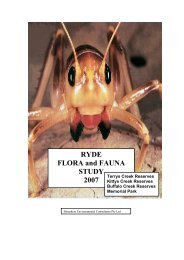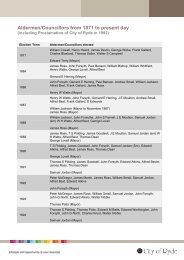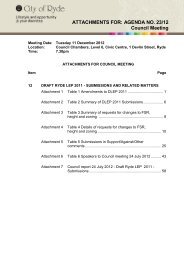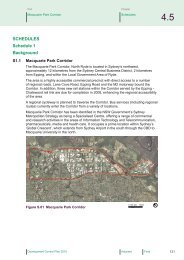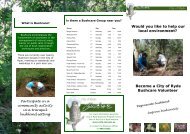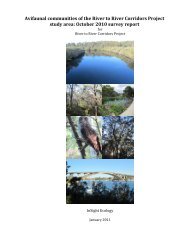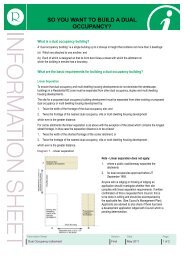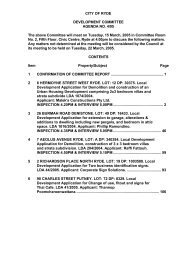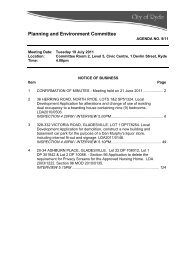RYDE FLORA and FAUNA STUDY 2008 - City of Ryde - NSW ...
RYDE FLORA and FAUNA STUDY 2008 - City of Ryde - NSW ...
RYDE FLORA and FAUNA STUDY 2008 - City of Ryde - NSW ...
You also want an ePaper? Increase the reach of your titles
YUMPU automatically turns print PDFs into web optimized ePapers that Google loves.
native undergrowth has left the ground-dwelling mammals highly vulnerable to attack by<br />
introduced predators.<br />
Large reptiles have been extensively eliminated. This includes goannas, large snakes,<br />
dragons (such as Bearded Dragons) <strong>and</strong> large skinks (such as Blue-tongue lizards).<br />
Many <strong>of</strong> these reptiles appear to have either been deliberately killed (mainly snakes),<br />
accidentally killed or killed by domestic animals.<br />
No large reptiles were found in the <strong>2008</strong> surveys.<br />
Frogs have suffered a precipitous decline in <strong>Ryde</strong>. Most reserves have just one or two<br />
species. There appears to be several reasons for the decline <strong>of</strong> frogs:<br />
* loss <strong>of</strong> ephemeral or still-water flooded sites<br />
* loss <strong>of</strong> creek catchment habitat<br />
* poor water quality<br />
* introduced predatory fish (notable the Plague Minnow, Gambusia<br />
holbrooki).<br />
Pond-breeding species are now confined to back-yard habitats <strong>and</strong> have been lost from<br />
creek areas. Most tree frogs have disappeared despite the amount <strong>of</strong> woodl<strong>and</strong> <strong>and</strong><br />
forest that has been retained. This is a direct consequence <strong>of</strong> the loss <strong>of</strong> breeding<br />
habitat.<br />
Most other animal groups have shown declines in diversity.<br />
The fauna groups that are still well represented in the area are forest <strong>and</strong> woodl<strong>and</strong><br />
birds. In some <strong>of</strong> the larger bushl<strong>and</strong> reserves the tree canopy has been retained <strong>and</strong><br />
reserves are close enough together so that birds can move freely between bushl<strong>and</strong><br />
areas. The birds that have declined markedly are the small passerines that require midcanopy<br />
cover for protection <strong>and</strong> wading birds.<br />
Invertebrates also reduced in abundance in the smaller <strong>and</strong> more urbanised reserves.<br />
1.2.3. Impacts<br />
The types <strong>of</strong> impacts on the bushl<strong>and</strong> areas varied but included:<br />
* weed invasion<br />
* dumping <strong>of</strong> garden wastes <strong>and</strong> household rubbish<br />
* planting <strong>of</strong> non-native or non-endemic plants<br />
* uncontrolled fires that alter plant communities<br />
* contamination <strong>of</strong> creeks <strong>and</strong> ground water<br />
* changes in flow patterns <strong>of</strong> creeks through storm water control<br />
* increased erosion <strong>of</strong> creek banks<br />
* loss <strong>of</strong> ephemeral freshwater habitat<br />
Biosphere Environmental Consultants Pty Ltd<br />
6




